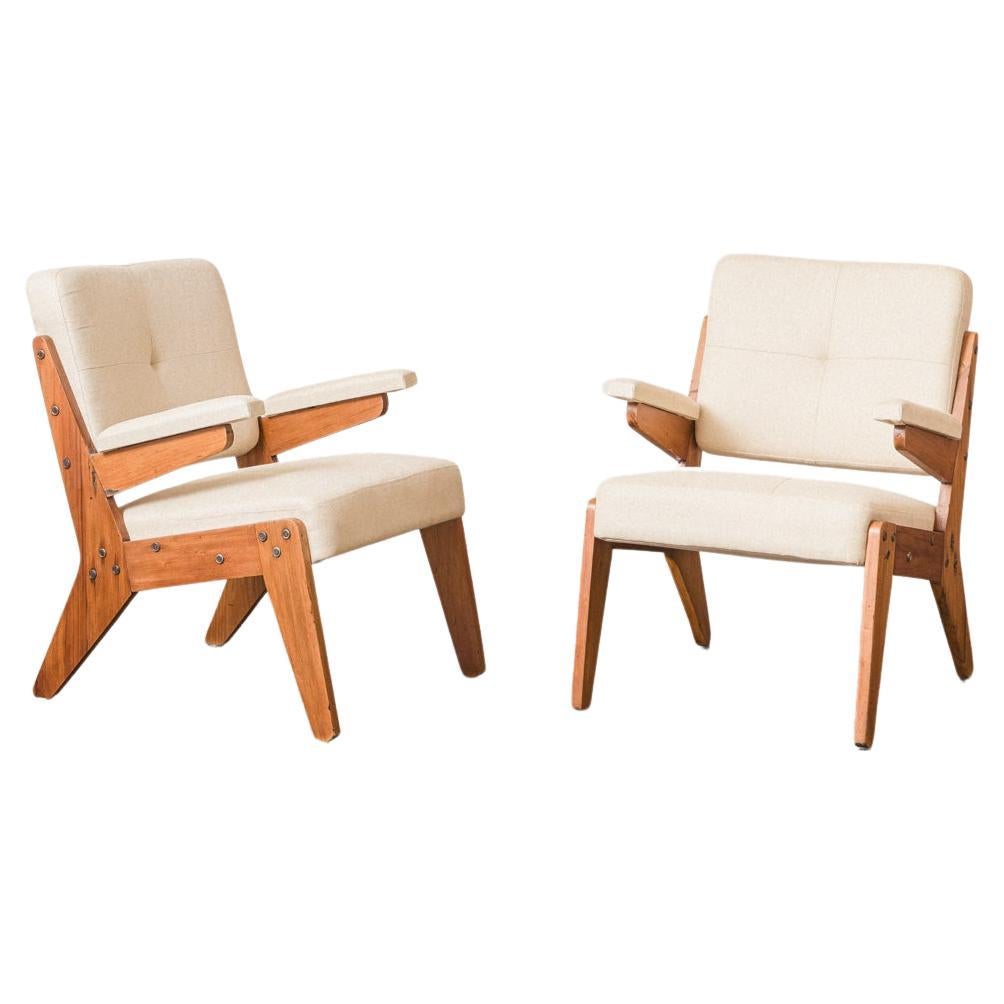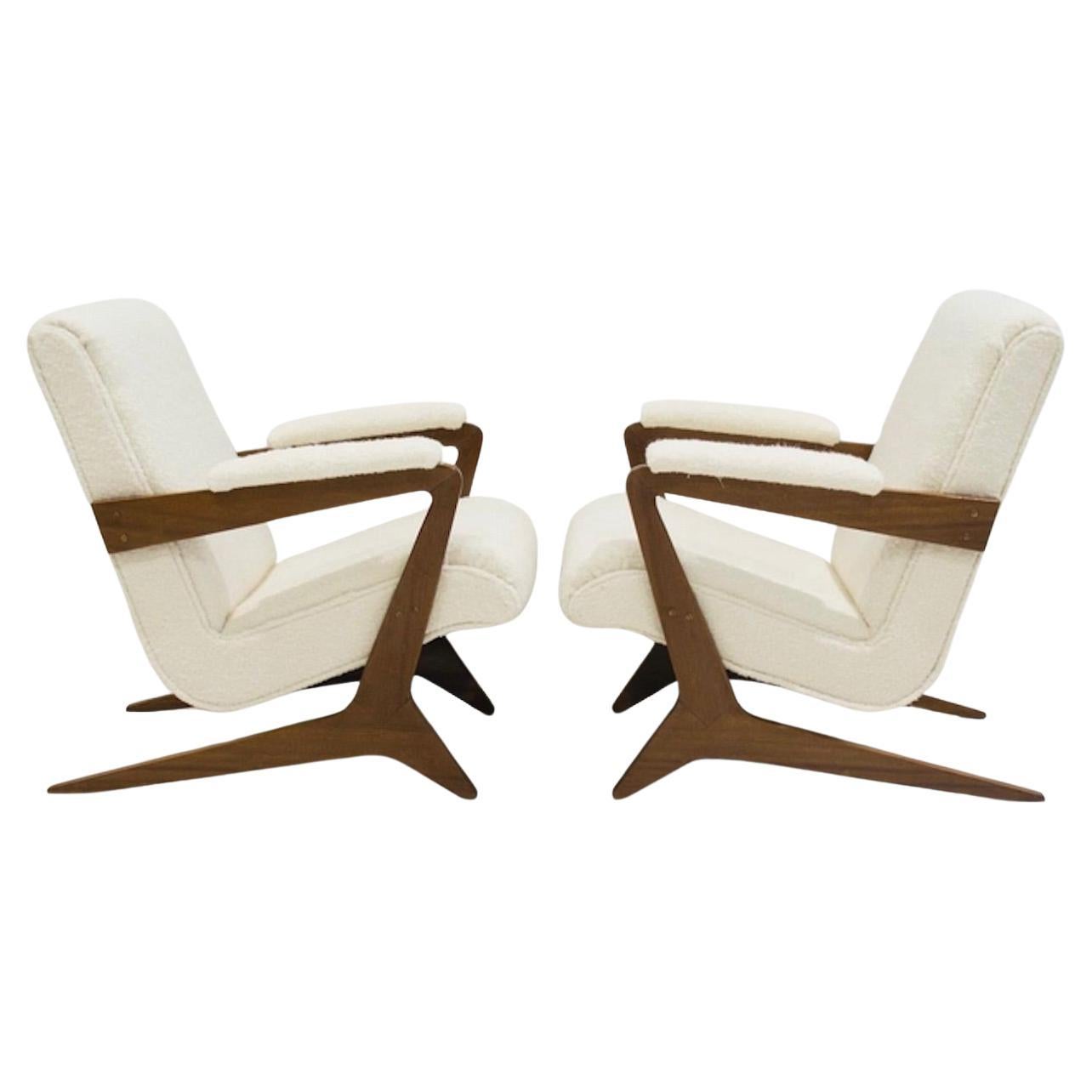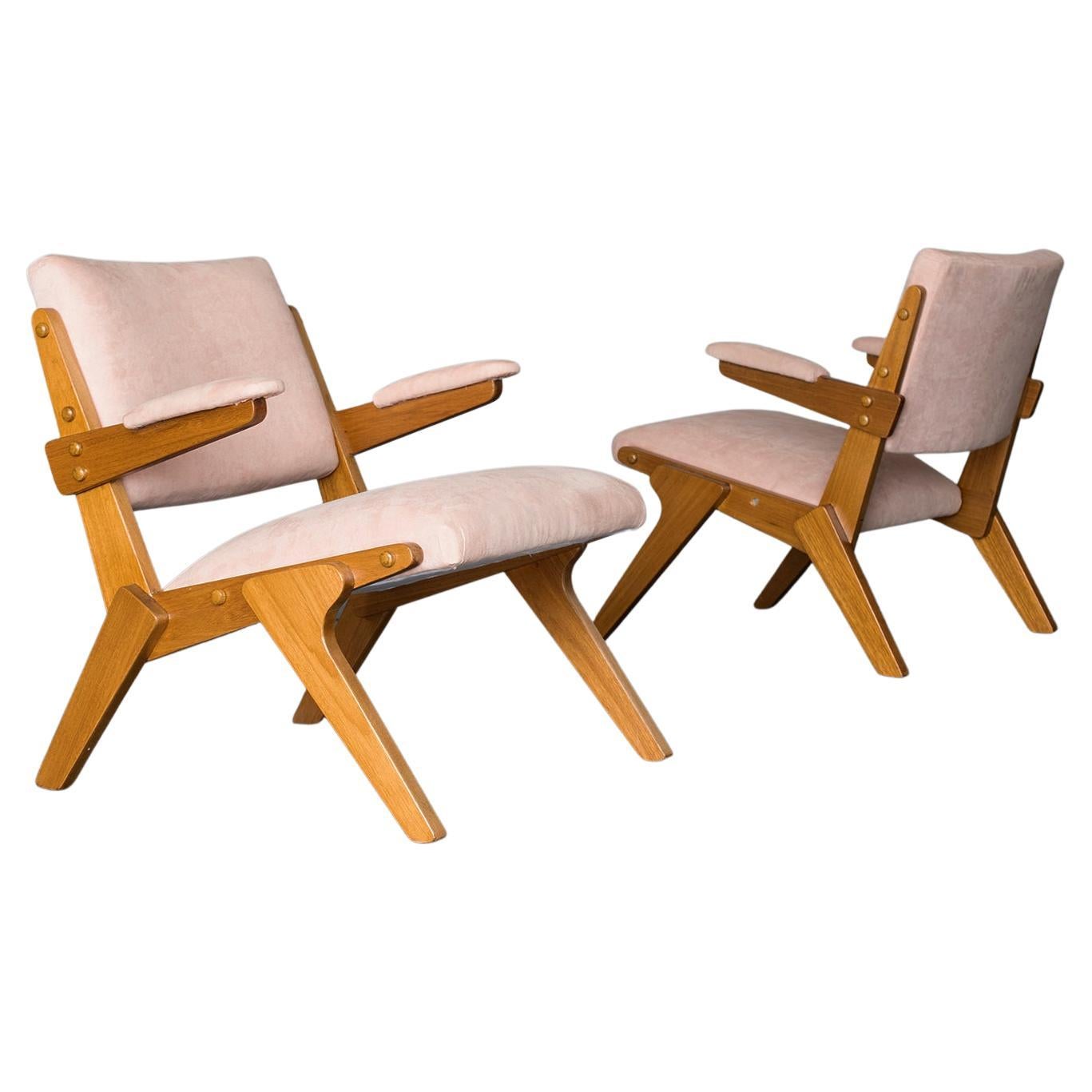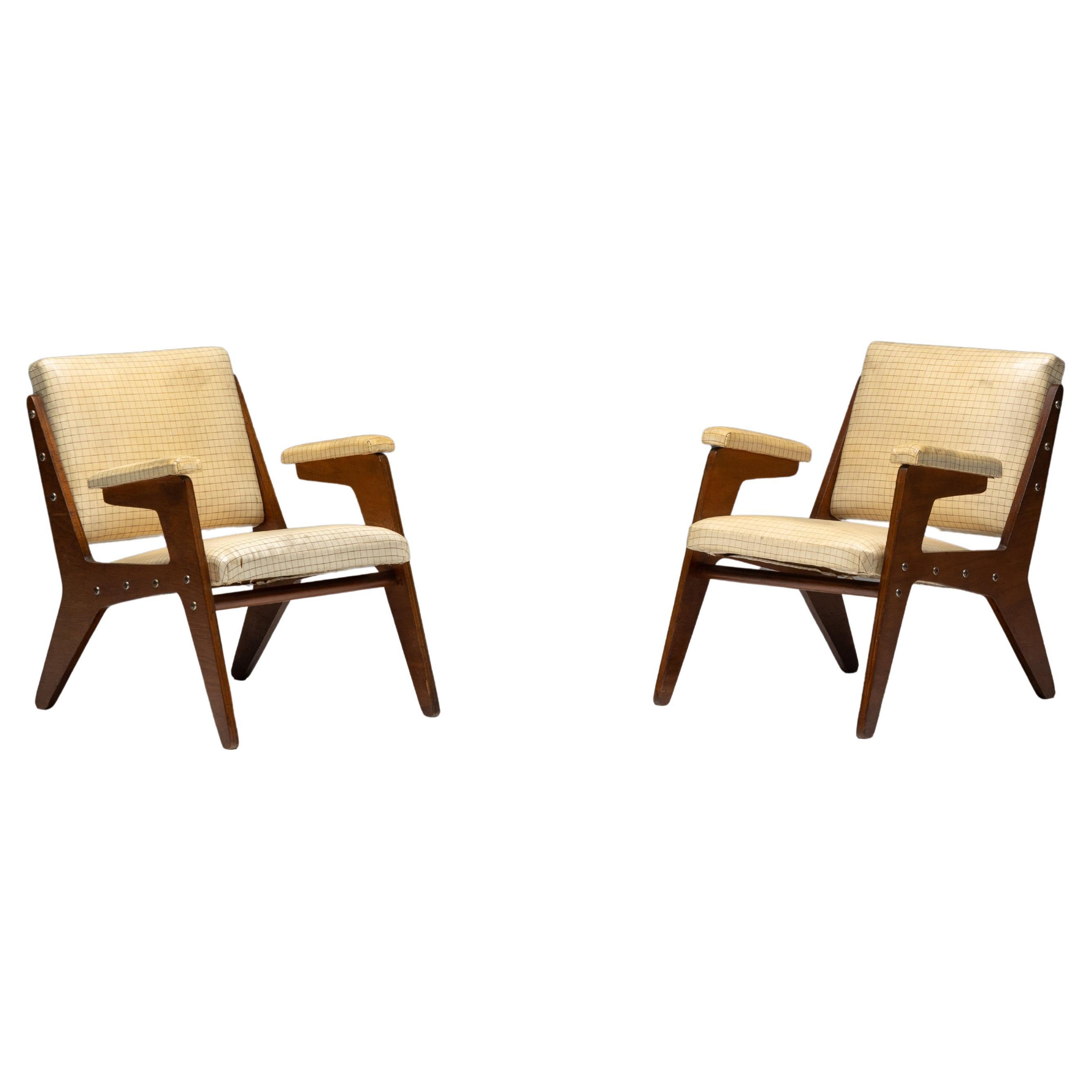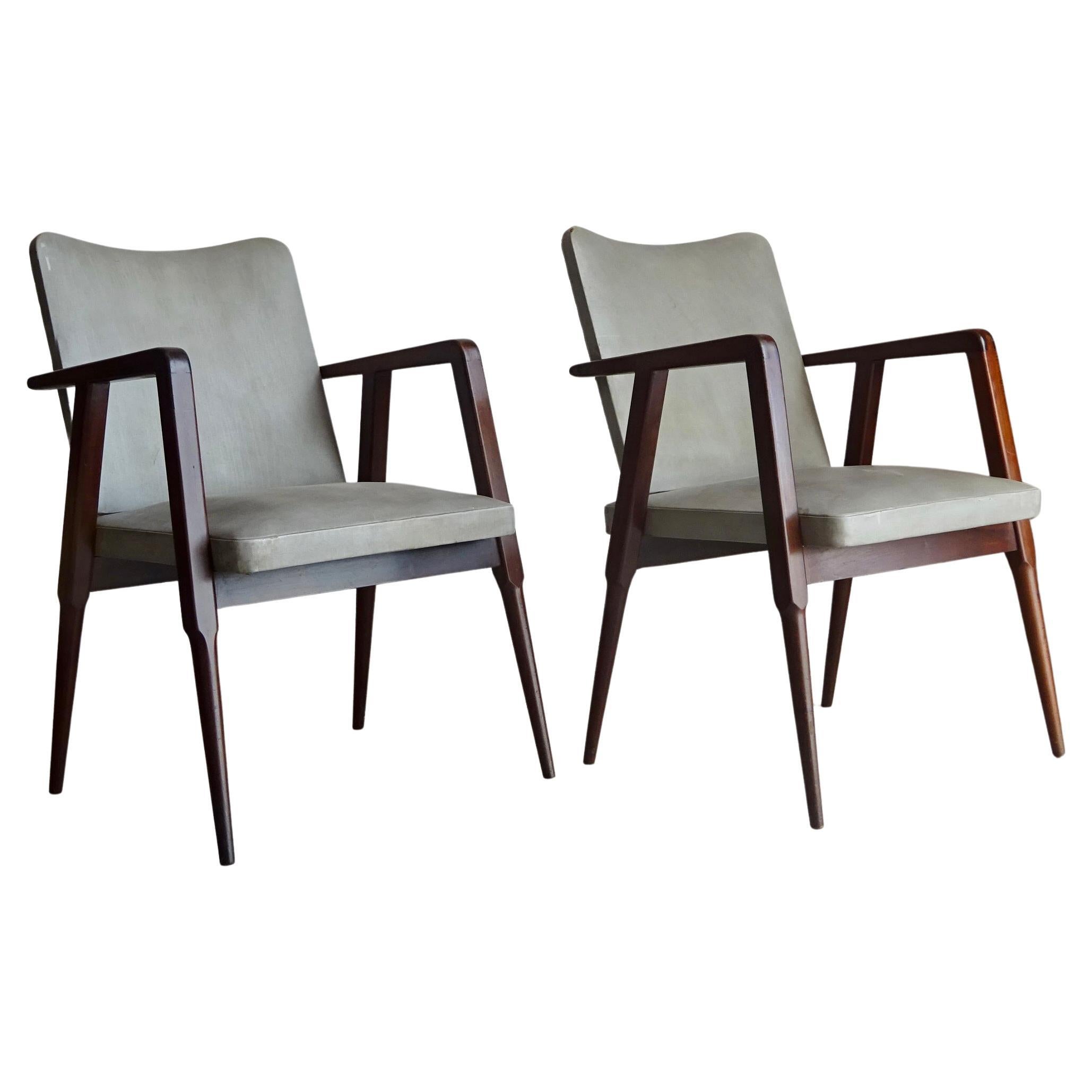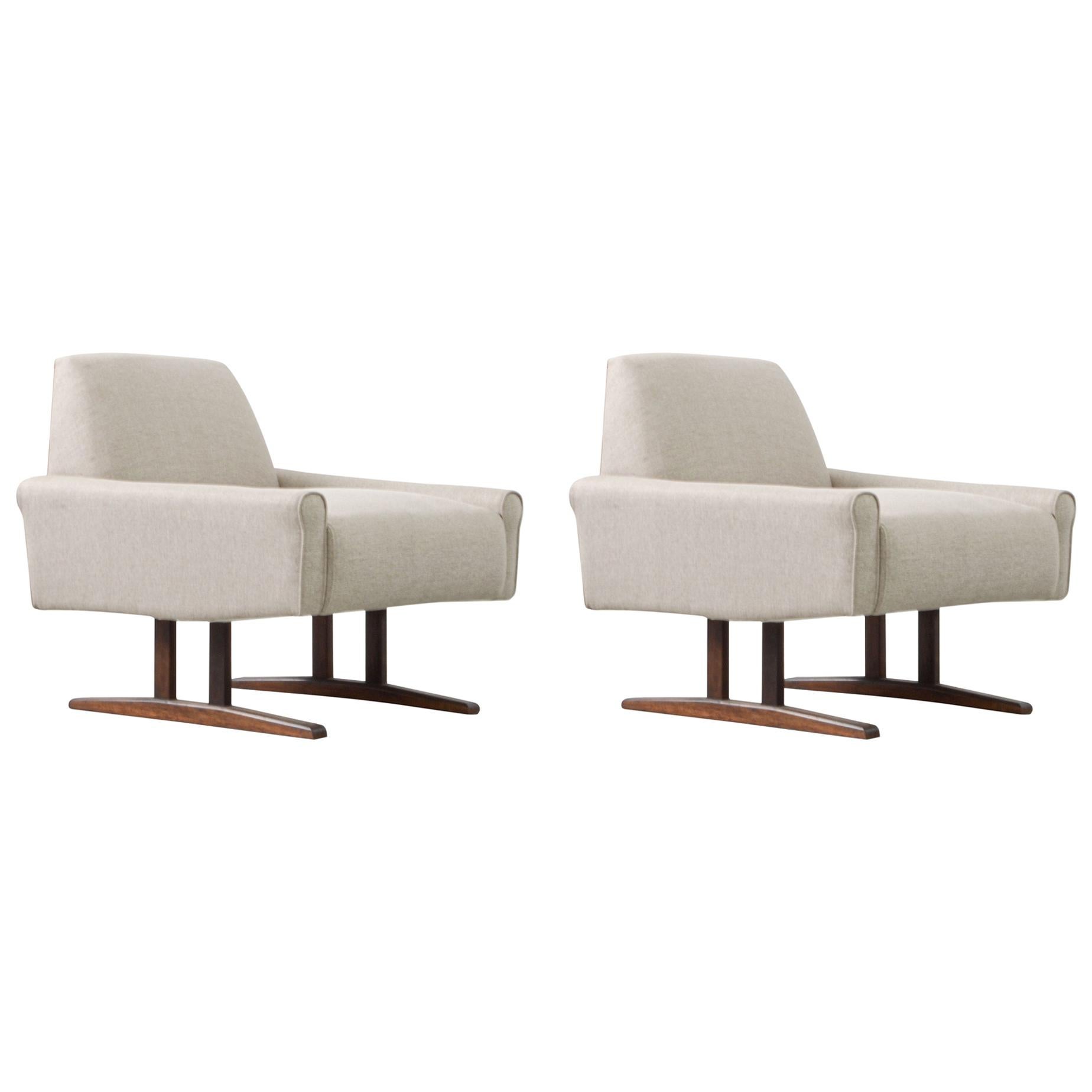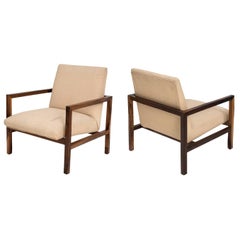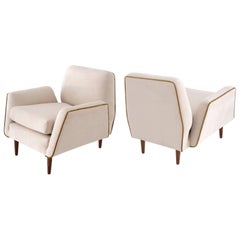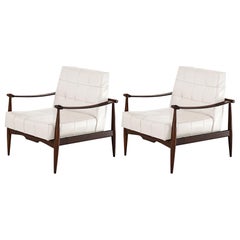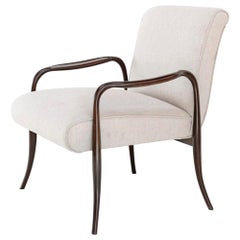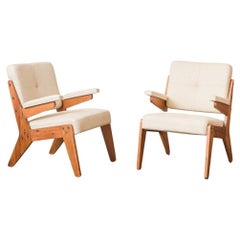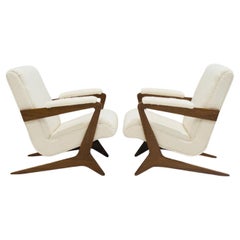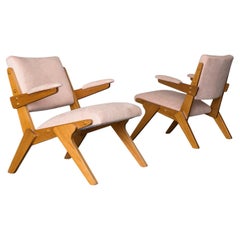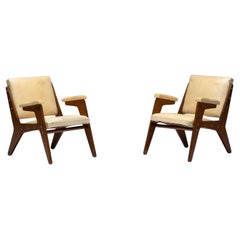Items Similar to Jose Zanine Caldas Pair of Mid-century modern BrazilianArmchairs Model "H"
Want more images or videos?
Request additional images or videos from the seller
1 of 7
Jose Zanine Caldas Pair of Mid-century modern BrazilianArmchairs Model "H"
$41,846.55per item
£30,979.08per item
€35,000per item
CA$57,905.16per item
A$63,839.12per item
CHF 33,398.57per item
MX$783,187.41per item
NOK 420,421.79per item
SEK 393,160.86per item
DKK 266,608.53per item
Quantity
About the Item
JOSE ZANINE DE CALDAS (1919-2001).
Pair of armchairs model “H.”
Manufactured by Moveis Artísticos Z.
Brazil, 1949.
Marine plywood, fabric upholstery.
Measuremenents
58 cm x 50 cm x 80 H cm.
Literature: Habitat, nº9, Sao Paulo 1952.
José Zanine Caldas (Belmonte, Bahia, 1918 - Vitória, Espírito Santo, 2001) was an architect and designer. Caldas stands out on the national architecture in Brazil for his exploration of the constructive qualities of Brazilian woods, defining his work with a warm rustic ambience, working on both high-end residential projects and also popular constructions.
Never actually training as an architect, he starting working in the 1940s as a designer at Severo & Villares and as a member of the National Artistic Historical Heritage Service (Sphan). He opens a maquet studio in Rio de Janeiro, where he worked between 1941 and 1948, and, at the suggestion of Oswaldo Bratke (1907-1997), moved the studio to São Paulo, from 1949 to 1955. The studio served important modern architects of the two cities, and was responsible for most of the models presented in the book Modern Architecture in Brazil, 1956, by Henrique E. Mindlin (1911-1971)..
During the 1940s, he also began developing and researching at the Institute of Technological Research of the University of São Paulo (IPT/USP), and was first introduced to plywood. In 1949, he founded the Fábrica Móveis Artísticos Z, with the objective of producing large-scale industrialized furniture, good quaility and afforable, the furniture was to be materialized using plywood sheets. This method minimized material waste and the need for artisan skills, as the parts were mechanically produced and the use of labor was only needed for the assembling of the furniture.
His time at Móveis Artísticos Z, in 1953 was rather short lived and left the company in 1953 and instead worked on landscape projects until 1958 in São Paulo, when he moved to Brasília, where he built his first house, also in 1958, and coordinated the construction of others until 1964. Appointed by Rocha Miranda to Darcy Ribeiro (1922-1997), he joined the University of Brasília (UnB) in 1962 and taught modeling classes until 1964, when he lost his position due to the military coup. He set off and travelled through Latin America and Africa, an experience that had a remarkable effect on his work.
On return to Brazil he built his second house, the first of a series of projects in the Joatinga region of Rio de Janeiro. In 1968, he moved to Nova Viçosa, Bahia, and opened a workshop, which ran up until 1980. His experience in the Bahian city was shaped by his renewed love and contact with nature, and he began working closely with environmentalists. In one of these collaborations, he participated in the project of an environmental reserve with the artist Frans Krajcberg (1921-2017) for whom he also designed a studio in 1971. The furniture he designed during this period, is reflective of his ecological sensitivity, his works were constructed with crude logs of wood, whose twisted lines inspire his drawings.
It is also in Nova Viçosa that the architect builds the Casa dos Triângulos (1970) and casa da Beira do Rio (1970), in which he adopted a very artisanal construction system with typical woods of the region. According to the historian and architecture critic Roberto Conduru, Caldas' performance was relevant for the diffusion of environmental values in architectural projects: a "taste for the alternative and the rustic was disseminated throughout the Brazilian territory [...], encouraged by environmental preservation campaigns, by the wear and tear of the current models in reinforced concrete and by the re-emergence of the regionalist ideal in the international panorama"1.
Between 1970 and 1978, he kept an office in Rio de Janeiro, where he returned in 1982. In 1975, the filmmaker Antonio Carlos da Fontoura made the film Arquitetura de Morar, about the houses of Joatinga, with a soundtrack by Tom Jobim (1927-1993), for whom Caldas designed a house. Two years later, the architect's work was exhibited at the Museum of Modern Art of Rio de Janeiro (MAM/RJ), at the São Paulo Museum of Art Assis Chateaubriand (Masp) in Belo Horizonte, and the following year at Solar do Unhão, in Salvador.
Between 1980 and 1982 The Helium House Olga Jr was designed and built in São Paulo. Caldas outlined the plans for the construction sourcing the all the wood, the actual assembly of the house was carried out by the owner. The house, is defined by wooden structure that stands out from the fence walls, the clay tile roof of wide eaves and the demolition materials that give the building the feeling of rusticity, warmth and nostalgia. The house was similar to those built in the 1970s for Eurico Ficher and Pedro Valente, in Joatinga.
In 1983, Calders founded the Center for the Development of Applications of The Woods of Brazil (DAM), and gave it to UnB in 1985. During this period, he proposed the creation of the Escola do Fazer, a teaching center focused on the use of wood for the construction of houses, furniture and utilitarian objects for the low-income population.
Despite the fact that much of Calders early work was centered around building houses for the elite, in the 1980s the designer dedicates himself the DAM where he rigorously researches popular housing based on artisan construction processes and whereby the users participate in the construction process. At the Brasília unit, he developed prototypes of popular houses with eucalyptus logs as a structure and sealing in soil-cement, betting on an ideal of self-construction already tested at Casa do Nilo, in São Gonçalo, Rio de Janeiro. From that moment on, as occurred with his the furniture designs, Caldas adopts the use of crude wood logs rolled - and no longer rigged - usually discarded, allied to demolition materials, which radicalize the effect of rusticity and warmth. This method also spread to non-residential projects, such as the Barra das Princesas Agropecuária S. Fazenda Chapel in Araguaia, Mato Grosso, the chapels of Guarapari, Espírito Santo, and Itapissuma, Pernambuco and Pousada Pedra Azul, in Domingos Martins, Espírito Santo.
Calder’s success without a doubt was thanks to his modeling studio, where his clientele noticed his ability to propose solutions to the design problems he identified during the execution of the models. In 1986, however, the publication of his work in the magazine Projeto n. 90 initiated a controversy in the Regional Council of Engineering and Architecture (Crea) over the fact that Caldas was self-taught. Several architects jumped to his defense, among them Lucio Costa (1902-1998), who awarded him five years later, at the 13th Brazilian Congress of Architecture in São Paulo, with the title of honorary architect given by the Institute of Architects of Brazil (IAB). In 1989, he was reinstated to his post at UnB, but did not teach. That year, he traveled to Europe, where he designed residences in Portugal and taught at the École d ́Architecture in Grenoble, France. The Musée des Arts Decoratifs in Paris held an exhibition of design pieces in 1989, the same year he received the silver medal from the College of Architects of France.
The integration of industrialism of the 1950s and the ecologism of the 1970s a huge challenge to many industrial designers. This was a theme that was very much present in Calder’s work. It was this debate that removed the architect from the proposal of serialization carried out in Z and brought him back to craftsmanship and the indigenous language of Brazil, the house of the architect Carlos Frederico Ferreira (1906 - ca.1996) and Casa Hildebrando Accioly de Francisco Bologna (1923), are both examples of Calder’s connection with his grounded roots. José Zanine Caldas has left an important legacy, permeating both serial production and the priority of native manufacturing.
- Creator:José Zanine Caldas (Designer)
- Dimensions:Height: 31.5 in (80 cm)Width: 19.69 in (50 cm)Depth: 19.69 in (50 cm)
- Style:Mid-Century Modern (Of the Period)
- Materials and Techniques:
- Place of Origin:
- Period:
- Date of Manufacture:1949
- Condition:Minor losses.
- Seller Location:Barcelona, ES
- Reference Number:1stDibs: LU237436039963
About the Seller
5.0
Recognized Seller
These prestigious sellers are industry leaders and represent the highest echelon for item quality and design.
Established in 2015
1stDibs seller since 2016
99 sales on 1stDibs
Typical response time: 11 hours
- ShippingRetrieving quote...Shipping from: Casavells , Spain
- Return Policy
Authenticity Guarantee
In the unlikely event there’s an issue with an item’s authenticity, contact us within 1 year for a full refund. DetailsMoney-Back Guarantee
If your item is not as described, is damaged in transit, or does not arrive, contact us within 7 days for a full refund. Details24-Hour Cancellation
You have a 24-hour grace period in which to reconsider your purchase, with no questions asked.Vetted Professional Sellers
Our world-class sellers must adhere to strict standards for service and quality, maintaining the integrity of our listings.Price-Match Guarantee
If you find that a seller listed the same item for a lower price elsewhere, we’ll match it.Trusted Global Delivery
Our best-in-class carrier network provides specialized shipping options worldwide, including custom delivery.More From This Seller
View AllBranco e Preto Pair of Modern Brazilian Armchairs solid jacaranda wood, fabric
By Branco & Preto
Located in Barcelona, ES
Branco e Preto (Miguel Forte, Jacob Ruchti, Plinio Groce, Roberta Aflalo, Carlos Millan & Che Y Hwa)
Pair of armchairs model “R3”
Sold as individual it...
Category
Mid-20th Century Brazilian Mid-Century Modern Armchairs
Materials
Upholstery, Jacaranda
Martin Eisler & Carlos Hauner Pair of Modern Brazilian Armchairs wood and velvet
By Carlo Hauner and Martin Eisler, Forma Brazil
Located in Barcelona, ES
Martin Eisler (1913-1977) & Carlos Hauner (1927-1997)
Pair of armchairs
Manufactured by Forma Moveis
Brazil, 1955
Caviuna wood legs, velvet and cotton upholstery
Measurements:
77 cm x 77 cm x 72 H cm.
30.3 in x 30.3 in x 28.3 H in.
Literature:
Casa & Jardim, 1956. Nº 92
Details:
Belonging to a three pieces set of sofa and two armchairs.
Category
Mid-20th Century Brazilian Mid-Century Modern Armchairs
Materials
Upholstery, Wood
Liceu De Artes e Oficios Pair of Midcentury Brazilian Jacaranda Armchairs Cream
By Liceu de Artes e Ofícios
Located in Barcelona, ES
Liceu de artes e oficios
Pair of armchairs
Manufactured by Liceo de Arte e Oficios
Brazil, 1950
Solid jacaranda and upholstery
Cream upholstered Mid-Century Modern
Measure...
Category
20th Century Brazilian Modern Armchairs
Materials
Upholstery, Jacaranda
Joaquim Tenreiro Pair of Armchairs Model “Leve”, Brasil, 1942
By Joaquim Tenreiro
Located in Barcelona, ES
Joaquim Tenreiro
Pair of armchairs model “Leve”
Manufactured by Langenbach & Tenreiro Ltda
Brasil, 1942
Jacaranda, upholstery
From the archives of Side Gallery, Barcelona
M...
Category
Vintage 1940s Brazilian Armchairs
Materials
Fabric, Jacaranda
Joaquim Tenreiro, Pair of Armchairs, 1950
By Joaquim Tenreiro
Located in Barcelona, ES
Pair of armchairs
Manufactured by Tenreiro Moveis e Decoraçaos
Brasil, 1950
Upholstery, jacaranda legs
Measurements:
67 cm x 89 cm x 73 H cm
26.38 in x 35.04 in x 228.75 H in...
Category
Vintage 1950s Brazilian Armchairs
Materials
Jacaranda
$17,216 / set
Joaquim Tenreiro Pair of Armchairs Model “Concha” Brasil, 1950
By Joaquim Tenreiro
Located in Barcelona, ES
Joaquim Tenreiro
Pair of armchairs model “Concha”
Manufactured by Tenreiro Moveis e Decoraçaos
Brasil, 1950
Pau marfim wood, upholstery
From the archives of Side Gallery, Barce...
Category
Vintage 1950s Brazilian Armchairs
Materials
Fabric, Wood
You May Also Like
Rare Pair of Armchairs by Jose Zanine Caldas
By José Zanine Caldas
Located in London, England
Rare armchairs designed by Jose Zanine Caldas for "Moveis Asrtisticos Z".
Category
Vintage 1950s Brazilian Mid-Century Modern Chairs
Materials
Leather, Plywood
Price Upon Request
Pair of José Zanine Caldas Zeca Armchairs
By José Zanine Caldas, Mòveis Artisticos Z
Located in Madrid, ES
The "Zeca" chair was created in the early 1960s by a Brazilian designer José Zanine Caldas (1918-2001) for Móveis Artísticos Z, a factory he founded in São José dos Campos in 1948. T...
Category
Mid-20th Century Brazilian Mid-Century Modern Armchairs
Materials
Bouclé, Hardwood, Plywood
$45,238 / set
José Zanine Caldas Armchairs, Pair, 1950s, Brazil
By José Zanine Caldas
Located in Tokyo, Tokyo
A pair of beautiful armchairs designed by José Zanine Caldas from Brazil.
Reupholstered with light pink colored fabric.
Very good vintage condition.
Category
Vintage 1950s Brazilian Mid-Century Modern Armchairs
Materials
Upholstery, Wood
$23,000 / set
'H' Armchairs by José Zanine Caldas, Brazil, 1950s
By José Zanine Caldas
Located in Antwerp, BE
This set of two lightweight armchairs by José Zanine Caldas exemplifies his mastery of form and material. Constructed with two precision-cut plywood pieces screwed to the seat and ba...
Category
Vintage 1950s Brazilian Mid-Century Modern Armchairs
Materials
Fabric, Plastic, Plywood
Pair of Cimo armchairs. Brazil, 1950s.
By Moveis Cimo
Located in Barcelona, ES
Pair of Cimo armchairs in "imbuia" wood. Brazil, 1950s. Original condition.
Category
Vintage 1950s Brazilian Mid-Century Modern Armchairs
Materials
Fabric, Hardwood
$3,347 / set
Rare Midcentury Pair of L'Atelier Armchairs Made by Brazilian Hardwood
By L’Atelier
Located in Sao Paulo, SP
This beautiful pair of armchairs designed by L'Atelier is a great example of the style of Brazilian midcentury furniture. The materials...
Category
Mid-20th Century Brazilian Mid-Century Modern Armchairs
Materials
Rosewood
More Ways To Browse
Mid Century Fence
Utilitarian Furniture
South American Plywood Lounge Chairs
Aztec Chairs
Bambino Chair
Barley Twist Carved Throne
Barnard And Simonds Chairs
Bauhaus Z Chair
Beaded Arm Chair
Beata Heuman Marbleized Velvet
Beata Heuman Marbleized
Bentwood Barrel Chairs
Bergere Tobia Scarpa
Bergmann Chair
Bernard Govin Elliptique
Bernard Massot
Berry Armchair
Black Upholstered Chair With Swan Arms
